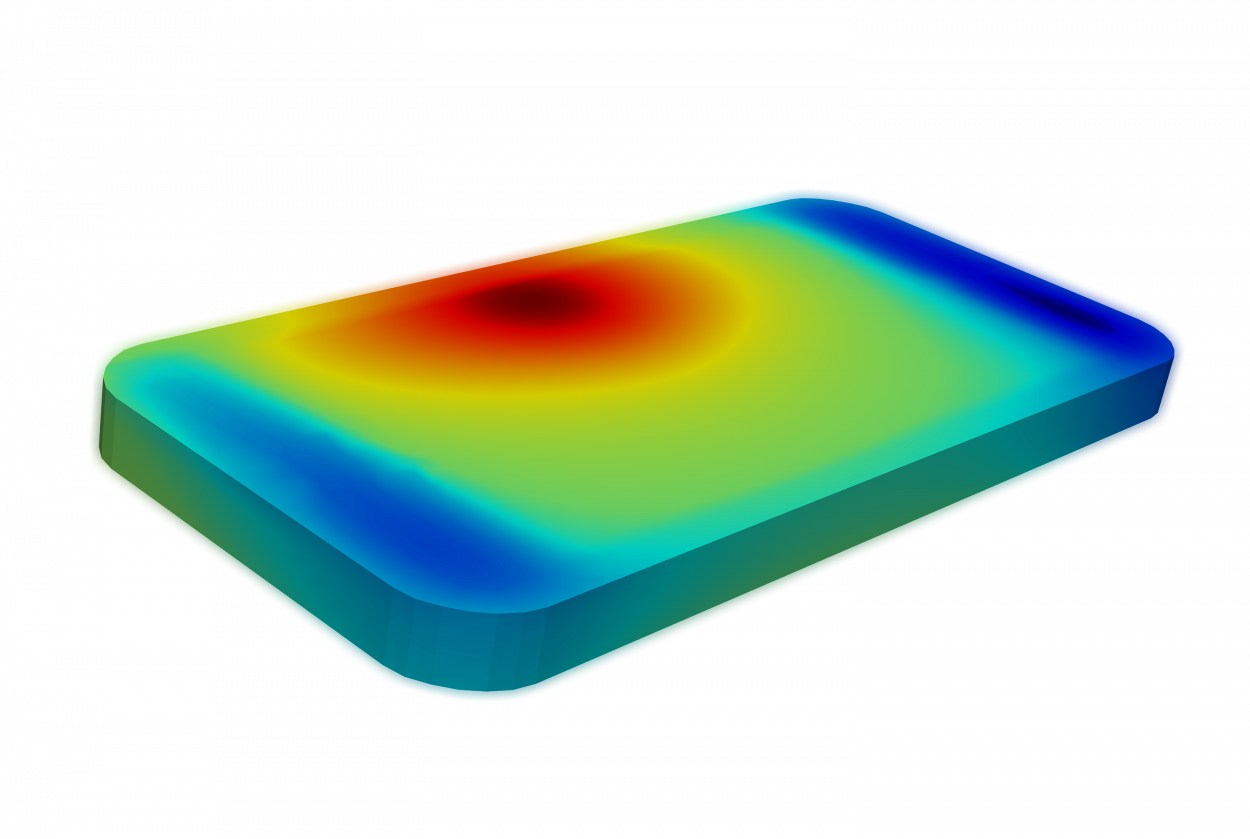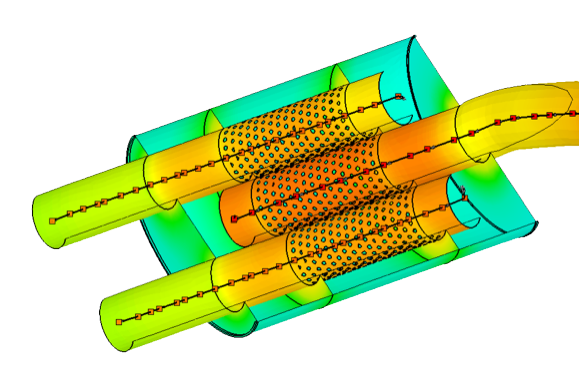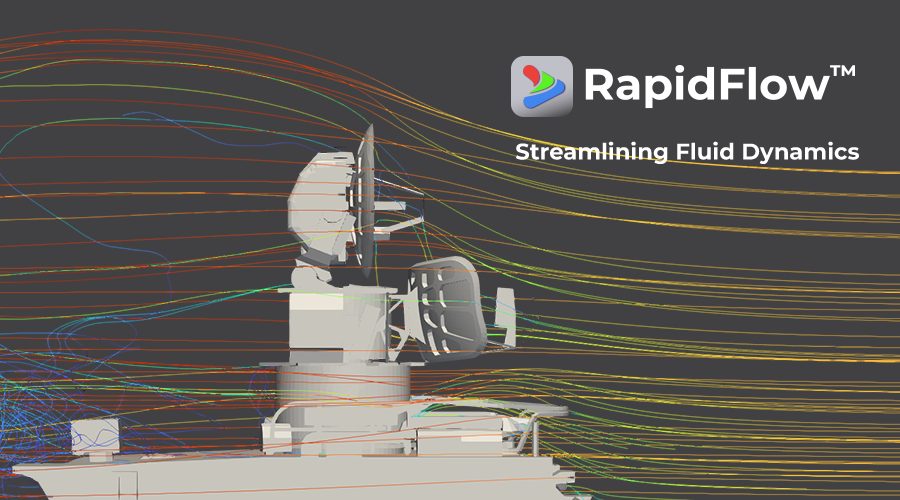What’s beyond ‘realistic’? Reality-based in first-principles physics.
MuSES® EO/IR Signature simulation software computes at-sensor
radiance in every waveband from visible gray through infrared
and out to millimeter wavelengths.
Validated EO/IR Accuracy
Electro-optic and infrared renderings in MuSES achieve global benchmark accuracy through a stepwise workflow – beginning with heat sources such as engines, exhaust, bearings, and electronics, followed by an in-band diffuse radiosity solution. Then place your sensor at-range and render multi-bounce, spectrally-summed radiance values, with DeltaT-RSS contrast metrics. Sensor response curve handy? Import it and see what you’ve been missing. With MuSES, you have reality at your fingertips.
Rapid Design for LO
Because MuSES covers physics all the way back to heat sources and environmental loads, you can manage thermal signature contrast and evaluate control kits for low observables design in any global location. Heat shields, cooling schemes, even camo surface treatments can be tested and evaluated for in-band radiance, replete with atmospheric attenuation along sensor line-of-sight. Triage and prioritize your engineering with MuSES early in the development cycle.
Enhance Defense Simulations with RapidFlow™
RapidFlow™, our latest software extension, brings unparalleled speed and accuracy to MuSES™ thermal simulations. Designed to meet the demanding needs of defense applications, RapidFlow™ accelerates complex transient thermal analyses. Whether modeling vehicle signatures, optimizing camouflage, or evaluating thermal dynamics in mission-critical environments, RapidFlow™ ensures faster insights to give you a tactical edge.
Features
Sensor Prediction
Place your sensor at any range, lookdown angle, and azimuth, whether at short range near ground or from aerial and satellite platforms. MuSES signature prediction software takes care of the rest, computing source radiance for both targets and backgrounds, direct, diffuse, and reflected solar, and spectral sources like sky radiance and water reflections. The source radiance is then spectrally attenuated back to the sensor location. Easily script up multiple ranges and LOS’s to build a complete library of band-specific contrast values.
Probability of Detection
Often probability of detection (POD) is computed for numerous ranges from target to sensor; with MuSES you can consider it done. But don’t stop there. MuSES enables your team to test low observables designs, examine operational profiles for vulnerable, high-contrast situations, and even plan the best times for execution. Because MuSES deals in reality, you get accurate POD metrics and can design, plan, and develop systems with speed and confidence.
Satellite Imagery Analysis
Observing individuals, ships, vehicles, and aircraft on the ground from satellites and aerial platforms requires accurate atmospheric attenuation along the sensor line of sight. MuSES employs calls to MODTRAN, the benchmark for physics-based atmospheric radiance computations, along with weather data and solar intensity to yield accurate renderings of ground-based assets. Solar loading, thermal shadows, thermal behavior, and thermal lag are all computed over long time periods to accurately capture the temperature distribution and source radiances for the sensor wave band. Rendering with multi-bounce ray tracing yields physically accurate and realistic contrast metrics.
Remote Imagery Analysis
Using texture mapping, remote imagery can be used to impose a temperature distribution on terrains. This enables you to drive an aerial scenario with realistic terrain temperature distribution on a faceted background component. Targets can be placed on the terrain and rendered against complex, cluttered backgrounds.
Thermal Analysis
MuSES includes the globes’ most advanced thermal solver, TAITherm thermal analysis software, employed by the leading vehicle and aircraft OEMs to rapidly solve thermal behavior and thermal management problems. Because many EO/IR signature challenges are rooted in thermal behavior, MuSES accurately simulates heat transfer and can thus be a virtual test platform for low observables kits or primary system analysis.
See What It Can Do
Curious about MuSES' capabilities? Watch this.
Thermal and EO/IR Signature simulation software that is incredibly fast without sacrificing accuracy.
Transient Thermal Signature Predictions for Your Design
MuSES focuses on transient signature analysis to deliver answers faster without sacrificing accuracy. Reduce your production time while providing optimized designs.
Extensions

Take Charge with Thermal Simulation
The Battery Extension is designed to analyze the complexities of your batteries at a cell and pack level. As a licensed component of TAITherm, it uses thermal simulation to determine the lifetime, durability, and safety of your battery system. You can verify design choices, and mitigate complications due to safety issues including thermal runaway and aging.

Beyond Comfortable
Our Human Thermal Extension is the state-of-the-art technology for predicting human thermal comfort, safety, and effectiveness. It operates within our thermal analysis software, TAIThermTM, to comprehensively simulate human thermal sensation and thermoregulation under transient and asymmetric environmental conditions. Users can simulate all thermoregulatory responses based on many factors, including activity level. We have developed a comprehensive library of standard human models in various poses, including female and male physiologies. We have also developed an extensive clothing database for rapid model setup.

Improved Heat Protection Strategies
The Exhaust Extension uses transient thermal simulation to solve thermal challenges in one of a vehicle's most complex systems: the exhaust system. With a library of pre-built components and a simple set-up process, you can optimize your exhaust system design quickly and understand how it will perform in hot soak or time-based scenarios. The Exhaust Extension is built to reduce set-up time, generate results quickly, and provide realistic solutions with transient simulation.

RapidFlowTM is a 3D flow solver integrated with TAIThermTM and MuSESTM designed for convective heat transfer analysis. RapidFlowTM works on complex 3D geometries, has minimal setup time with automatic meshing, and is a powerful transient solver that rapidly calculates accurate thermal results. This combination provides automated thermal-fluid coupling within a single software solution, streamlining your workflow and increasing efficiency.
Getting Started
Training
The most efficient way to get started is to attend our two-day training. After the training, you will be proficient at using the MuSES Thermal signature prediction software on your own. Additional training is available to cover advanced topics such as infrared simulations, human comfort analysis, thermal comfort simulations, or advanced coupling processes such as steady-state coupling. We offer two training sessions a year in southeast Michigan, or we can arrange private training at your office.
Tutorials
Start on your own. Our step-by-step tutorials cover basic and advanced techniques. Once you have a software license, these tutorials are available for you to advance your knowledge.
Support
We are here to answer your questions at every step. We support our customers before and after the sale, our commitment to you never changes.
Resources
EV Modeling Capabilities of TAITherm Webinar
As OEMs are electrifying their vehicle fleets, electrical component modeling is becoming increasingly critical to the design of electric vehicles and variations of the hybrid electric vehicle (xEV). Vehicle range and cabin comfort are closely related in xEVs because the energy required to heat and cool the cabin comes from the battery pack. When modeling the additional loads on the battery pack, it is important to consider battery thermal management strategies to maintain the pack in an optimal operating range, especially for adverse thermal conditions in both hot and cold environments.
Reduce Vehicle Development Costs with Real-world Simulations
Vehicle testing is a complicated and costly endeavor. Organizations worldwide seek to replace their physical testing with accurate simulations to reduce costs, shorten design cycles, and discover higher-performing designs.
This webinar will discuss:
• Modern methods for virtual testing and validation
• Motivation for simulating vehicle test cycles
• How various methods for simulating test cycles compare
• Commercially available tools that enable the simulation of vehicle test cycles with a low computational cost, and high accuracy
Balancing Range and Occupant Thermal Comfort for Mass Transit Applications
The relationship between vehicle range and occupant comfort is an important consideration for EVs. Effective HVAC controllers are critical for maintaining the optimum occupant comfort while preserving vehicle range. Maintaining occupant comfort is more challenging for commercial vehicles; where the vehicle is large and has many occupancy configurations. In this webinar, you will learn how to accurately simulate this tradeoff using a coupled transient simulation with TAITherm and GT-SUITE.
New Features Webinar 2020.2
Join us as Daniel and Allison, two of our talented thermal and CFD engineers, walk you through the new features and enhancements in our TAITherm and CoTherm software. This webinar will include demonstrations inside our software and Q&A following the presentation.
Vehicle Cabin Energy Management Considerations in EVs Webinar
Environmental effects, cabin HVAC efficiency, and battery thermal management are just a few of the variables that contribute to electric vehicle range reduction. Join us as we explore common EV cabin studies with our TAITherm software. We will also show you how the Human Thermal Extension can be utilized to improve vehicle designs for shorter passenger time to comfort, while reducing energy consumption.
TAITherm Underhood Thermal Protection Coupling with an Advanced Open-Source Simulation Engine (HELYX) Developed Using OpenFOAM Technology Webinar
Coupling between TAITherm and the open-Source CFD software, HELYX, enables more realistic representations of complex systems to yield more accurate predictions. With this process, both steady-state and transient coupling scenarios can be applied. Using CoTherm, these tools are coupled seamlessly, offering OpenFOAM technology and processes within CoTherm’s usable interface. During the webinar, TAITherm coupling with HELYX through CoTherm will be presented, with specific application towards a coupled engine thermal protection case using the DrivAer SUV model and a detailed engine compartment.
Battery Modeling for Performance, Lifetime, and Safety Webinar
As battery technologies advance and consumers expect extended range and shorter charge times, using transient thermal simulation to predict battery performance has become increasingly crucial. Join us as Dr. Zachary Edel, one of our senior research engineers, demonstrates how you can leverage our TAITherm software and Battery Extension to accurately predict battery performance, lifetime, and safety in a wide range of real-world environmental conditions.
New Features 2020.1 Webinar
Curious what’s new in our latest software release? In the first release this year we have included a batch of features and enhancements to both programs to increase usability and productivity in your workflows. We have also deployed a new naming convention for easier recognition of the software versions. Our two annual releases are marked by the year and the version (2020.1, 2020.2). This coincides with our company rebrand, which you will see reflected in the software icons and welcome screens. Join us and follow along as one of our engineers presents what’s new, including demonstrations in the software.
Exceed Your Electrification Goals with Thermal Simulation
Industries are shifting to electrification across product lines, posing considerable challenges for engineers working to implement the new technology. In this webinar, you will learn how to surpass your electrification goals with thermal simulation. Zach, our in-house battery expert will take you inside our software to show you how to meet safety, reliability and lifetime requirements for the best design possible.
TAITherm v13.1/CoTherm v2.2 New Features
In this webinar we will cover:
- Tracking moisture transportation and accumulation using the new moisture transport feature
- Better sensation and comfort results with new segments added to the Berkeley Comfort Model
- Reducing model setup time and removing the margin for error by setting up your battery model in the main application
- Creating a more efficient workflow using the new subprocess group in CoTherm
